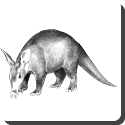 Aardvark — The Aardvark (Orycteropus afer) (“Digging foot”), sometimes called “ant bear” is a medium-sized mammal native to Africa. The name comes from the Afrikaans/Dutch for “earth pig” (aarde earth, varken pig), because early settlers from Europe thought it resembled a pig. However, the aardvark is not closely related to the pig, being placed in its own order. Nor is the aardvark closely related to the South American anteater, despite sharing some characteristics and a superficial resemblance. The closest living relatives of the aardvark are the elephant shrews, along with the sirenians, hyraxes, tenrecs, and elephants.
Aardvark — The Aardvark (Orycteropus afer) (“Digging foot”), sometimes called “ant bear” is a medium-sized mammal native to Africa. The name comes from the Afrikaans/Dutch for “earth pig” (aarde earth, varken pig), because early settlers from Europe thought it resembled a pig. However, the aardvark is not closely related to the pig, being placed in its own order. Nor is the aardvark closely related to the South American anteater, despite sharing some characteristics and a superficial resemblance. The closest living relatives of the aardvark are the elephant shrews, along with the sirenians, hyraxes, tenrecs, and elephants.
One of the most distinctive characteristic of the Tubulidentata is (as the name implies) their teeth. Instead of having a pulp cavity in their tooth, they have a number of thin tubes of dentine, each containing pulp held together by cementum. The teeth have no enamel coating and are worn away and regrow continuously. The Aardvark is born with conventional incisors and canines at the front of the jaw, which fall out and are not replaced. Adult Aardvarks only have cheek teeth at the back of the jaw, and have a dental formula of:
The Aardvark is nocturnal and is a solitary creature that feeds almost exclusively on ants and termites (formicivore); the only fruit eaten by aardvarks is the aardvark cucumber. An aardvark emerges from its burrow in the late afternoon or shortly after sunset, and forages over a considerable home range encompassing 10 to 30 kilometers, swinging its long nose from side to side to pick up the scent of food. When a concentration of ants or termites is detected, the Aardvark digs into it with its powerful front legs, keeping its long ears upright to listen for predators, and takes up an astonishing number of insects with its long, sticky tongue — as many as 50,000 in one night have been recorded. It is an exceptionally fast digger, but otherwise moves fairly slowly. Its claws enable it to dig through the extremely hard crust of a termite mound quickly, avoiding the dust by sealing the nostrils. When successful, the aardvark’s long (as long as 30 centimeters) tongue licks up the insects; the termite’s stinging attacks are rendered futile by the tough skin. Its keen hearing warns it of predators: lions, leopards, hyenas, and pythons.
Aside from digging out ants and termites, the aardvark also excavates burrows in which to live: temporary sites are scattered around the home range as refuges, and a main burrow is used for breeding. Main burrows can be deep and extensive, have several entrances and can be as long as 13 meters. The Aardvark changes the layout of its home burrow regularly, and from time to time moves on and makes a new one; the old burrows are then inhabited by smaller animals like the African Wild Dog. Only mothers and young share burrows. If attacked in the tunnel, it will seal the tunnel off behind itself or turn around and attack with its claws.
Aardvarks only pair during the breeding season; after a gestation period of 7 months, a single cub weighing around 2 kg is born, and is able to leave the burrow to accompany its mother after only two weeks, and is eating termites at 14 weeks and is weaned by 16 weeks. At six months of age it is able to dig its own burrows, but it will often remain with the mother until the next mating season, and is sexually capable by the season after that.
Aardvarks can live to be over 24 years old in captivity.
The aardvark’s main predators are lions, leopards, hunting dogs and pythons. Aardvarks can dig fast or run in zigzag fashion to elude enemies, but if all else fails, they will strike with their claws, tail and shoulders, sometimes flipping onto their backs to lash with all fours. Their thick skin also protects them to some extent.
 Kids Portal For Parents India Kids Network
Kids Portal For Parents India Kids Network






